This coming weekend sees a fascinating match-up in the English Premier League as Pep Guardiola takes his Manchester City side to Anfield to face Jurgen Klopp and Liverpool. Prior to the start of the season these two sides were seen as favourites to win the title and understandably so. Over the recent history of the Premier League we have seen historic iterations of these two sides. In the 2017/18 season Manchester City were the dominant force as they ended the season with 100 points. Next year, in the 2018/19 season we saw Liverpool close the gap at the top of the table although City were still the more dominant side as they won the title with 98 points to 97 for Liverpool. Next came the 2019/20 season and, despite the disruption caused by the COVID-19 pandemic, Liverpool were dominant as they ended the season as Champions on 99 points.
This season is, of course, a different proposition. As football, along with society as a whole, learns to adapt and learns how to operate in the midst of a pandemic the specific demands on football teams and those connected with those teams seems to be ever changing. While neiter of these sides should be in a position to plead poverty and financial hardship given their ownership methods they are still affected by the increased load in terms of fixture congestion and the fitness issues that this poses. This season has seen form almost go out the window as clubs find ways to adapt and to prepare for each upcoming fixture with ever diminishing preparation time.
Liverpool come into this match in fourth place on 40 points and following a 1-0 defeat in mid-week to an excellent and organised Brighton side. Manchester City on the other hand have weathered a difficult spell and are currently sitting top of the table on 47 points, although they have a game in hand on the rest of the top four.
Does this mean then that Manchester City come into the game as favourites, despite the game being at Anfield? Well, the answer to this is probably, yes. But only just.
Liverpool are experiencing a difficult spell at the moment. They are, of course, without a number of important first-team players and against Brighton they were missing; Allison, Virgil van Dijk, Joel Matip, Joe Gomez, Fabinho, Sadio Mane and Diogo Jota. This in itself is a stunning drain of top-level talent. Beyond the injury list, however, Liverpool seem to have hit on more structural problems as they appear passive both in and out of possession.
This brings us on to the focus of the piece. A tactical preview, or opposition report to give it a more club orientated spin is intended to specifically breakdown strenghts and weaknesses in the upcoming opponent before suggestion potential solutions to take advantage of these weaknesses and negate the strengths. This is, in essence, the root of tactics in football. The specific use of game principles to solve a problem that you will encounter on the field of play. We are told from an early age through television that tactics = formations and this could not be further from the truth. Formations and systems have their place in terms of basic occupation of space on the pitch but these spaces can shift decisively whether a team has possession or not. This leads us then to the crux of this article.
How will Manchester City look to progress the ball?
As a coach Pep Guardiola is a known advocate for the use of positional play as a means to build and create the framework in which his sides will play. The principles of this game idea surround the creation of superiority throughout the pitch in order to safely and securely progress the ball through the thirds and towards the opposition goal. These superiorities can be numerical, having more players than the opponent in a key area, positional, having a player in a position that allows the line of pressure from the opposition to be quickly outplayed (i.e a player between the lines of opposition midfield and defence who can cleanly receive the ball) and qualitative, when one group of players or player is bettern than their opponents. Imagine for example that you were lined up one on one with Raheem Sterling as the England international runs at you at pace. Without meaning to be disrespectful it is likely that Sterling would have the advantage over you as he attacks and breaks past you.
How City under Guardiola look to achieve the best structure for ball progression has changed. In their 100 point season City played with Fernandinho is as the ‘6’ and with David Silva and Kevin De Bruyne as free ‘8’s progression of the ball came from the central defenders who tended to find passing lanes to access eithe the ‘6’ or the ‘8’s. Now, with the Spanish international Rodri as the ‘6’ we have seen Guardiola alter his approach and to go back to a structure that we so successful when he was coach of Bayern Munich in the German Bundesliga.
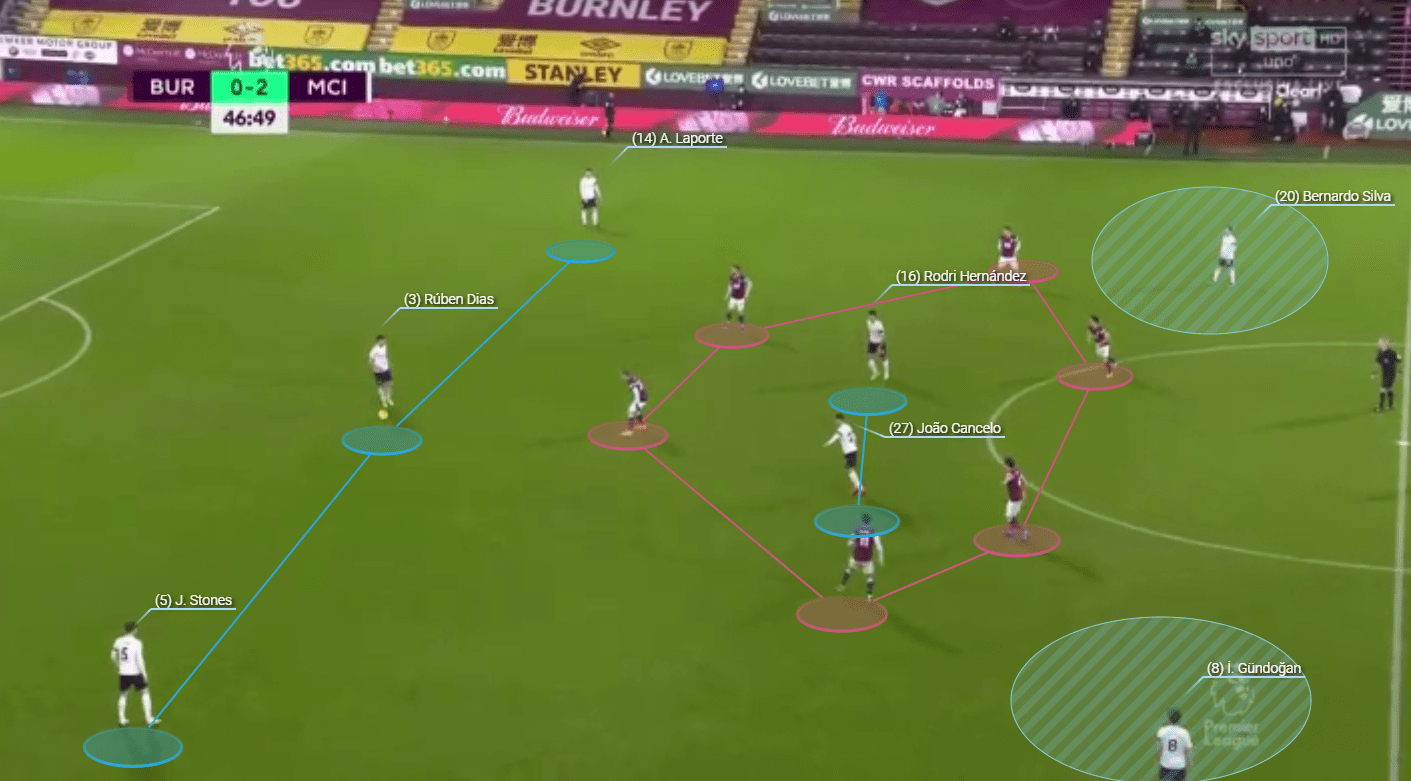
In their last match, against Burnley, we saw City line up with Aymeric Laporte at left-back. This in itself affected the way that the team would build-up as Laporte, although more than comfortable in possession of the ball, is not a rampaging and attacking fullback. This then created a line of three for City in the first line as they looked to build their attacks and progress the ball forward. Burnley, as most of you will already know, play with two fixed strikers and by having an extra player on the first line City automatically ensure that they have numerical superiority.
The key, however, comes on the next line where City essentially developed a double-pivot with the Portuguese international Joao Cancelo moving inside from his right-back slot to join Rodri at the base of the midfield.
As you can see from the image above this creates opportunities for City to play throught the Burnley press but more crucially it creates angles with the wide CB’s to find clean vertical passes that will find the two ‘8’s for City in space behind the opposition midfield line. From these positions City have numerous options with which to move the ball forward and into dangerous positions.
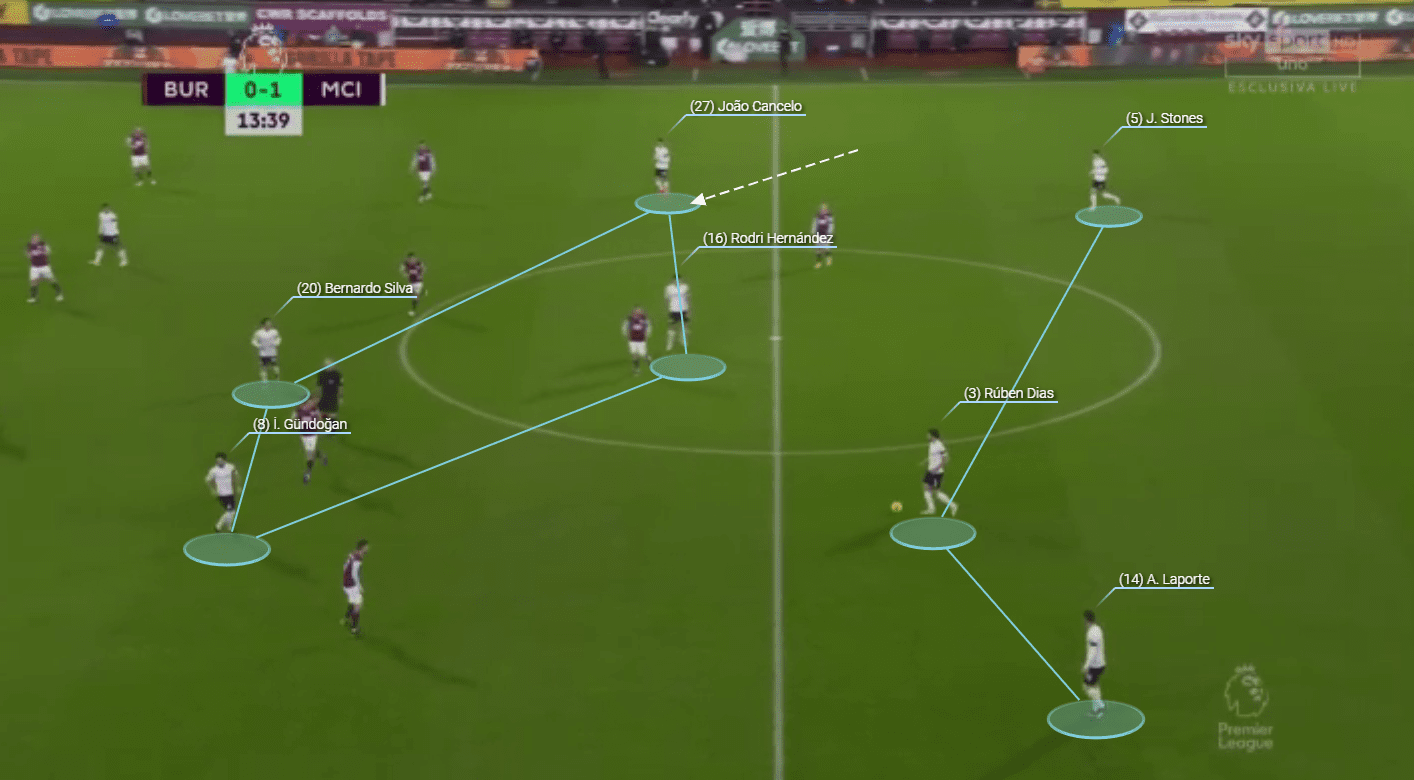
The inverted movements from Cancelo as he moves inside from the right-back position to occupy the half-spaces or central area is also interesting because it allows City to rotate their midfield into different areas to create numerical superiority. This is something that we see quite often from Leeds United under Marcelo Bielsa as their ‘8’s move to occupy the ball side of the field together to overload the opposition.
With Cancelo essentially occupying the space on the ball far side that would normally be occupied by an ‘8’ albeit on a deeper line there is now space for the ball to be progressed vertically on the ball side of the pitch.
These movements do, of course, mean that the players on the first-line have to be comfortable in playing the line breaking progressive pass. In this match Guardiola had three players on that first line who have this ability in abuncance. John Stones and Aymeric Laporte are well established but the decision to spend considerable money on Ruben Dias from Benfica now appears a masterstroke from the recruitment department at the club.
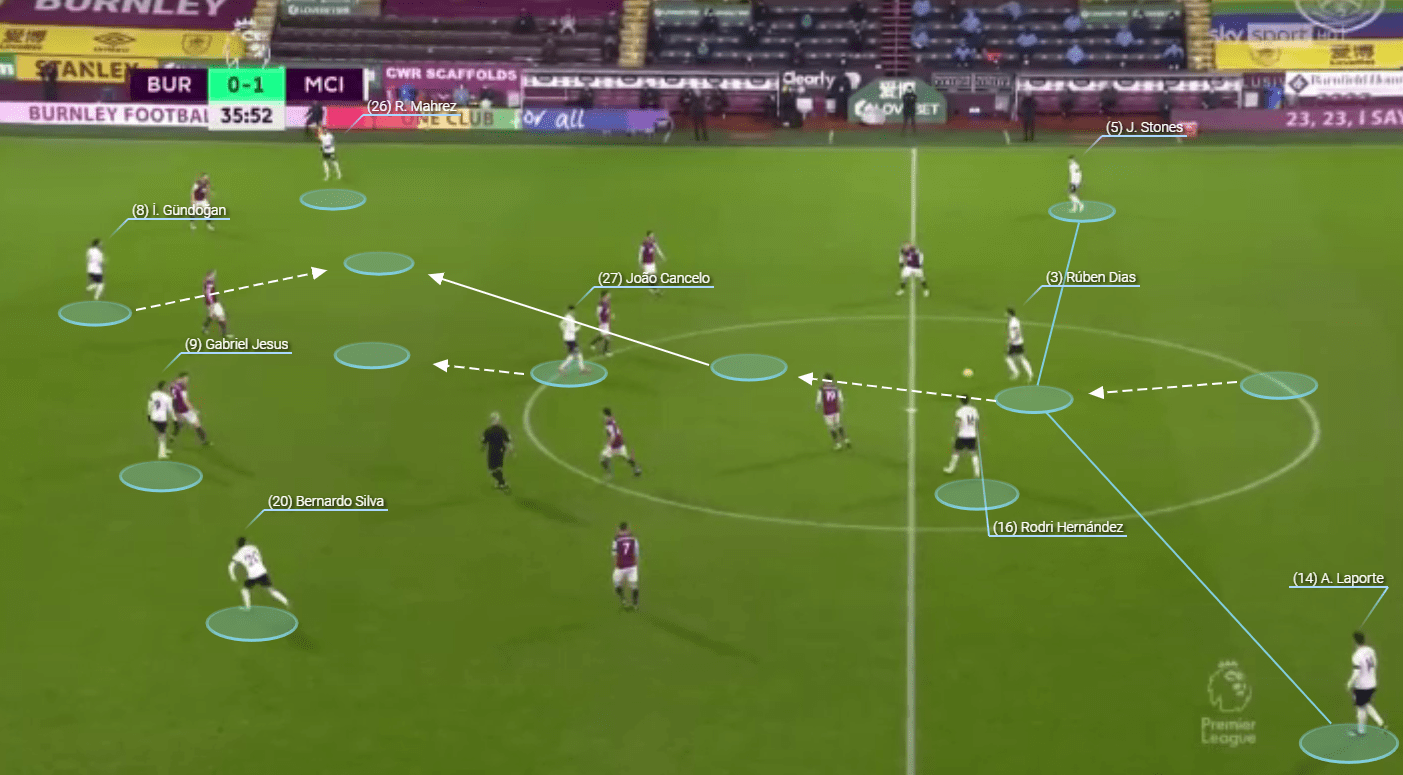
As they progress to the next level City then use vertical movements and clever rotations to empty and occupy pockets of space to allow the ball to be progressed in towards the final third of the pitch.
We have an example of this above with Ruben Dias progressing the ball from the first line. When he does not meet pressure he has the quality to bring the ball out from the back himself. We see this aboive as he steps through the first line to the second line and into a pocket of space that has been create by the movement of Joao Cancelo, who is positioned centrally, and who moves past the midfield line of the opposition to occupy intelligent space.
When Ruben Dias eventually does meet resistance he has passing options to play vertically either to Cancelo or to Ilkay Gundogan who has rotated back into the right-sided half-space.
Normally, these rotations would be less effective against Liverpool because under Klopp they are incredibly aggressive and proactive in terms of their pressing structures and styles. The fact that they appear becoming more passive in recent weeks, however, could cause them problems.
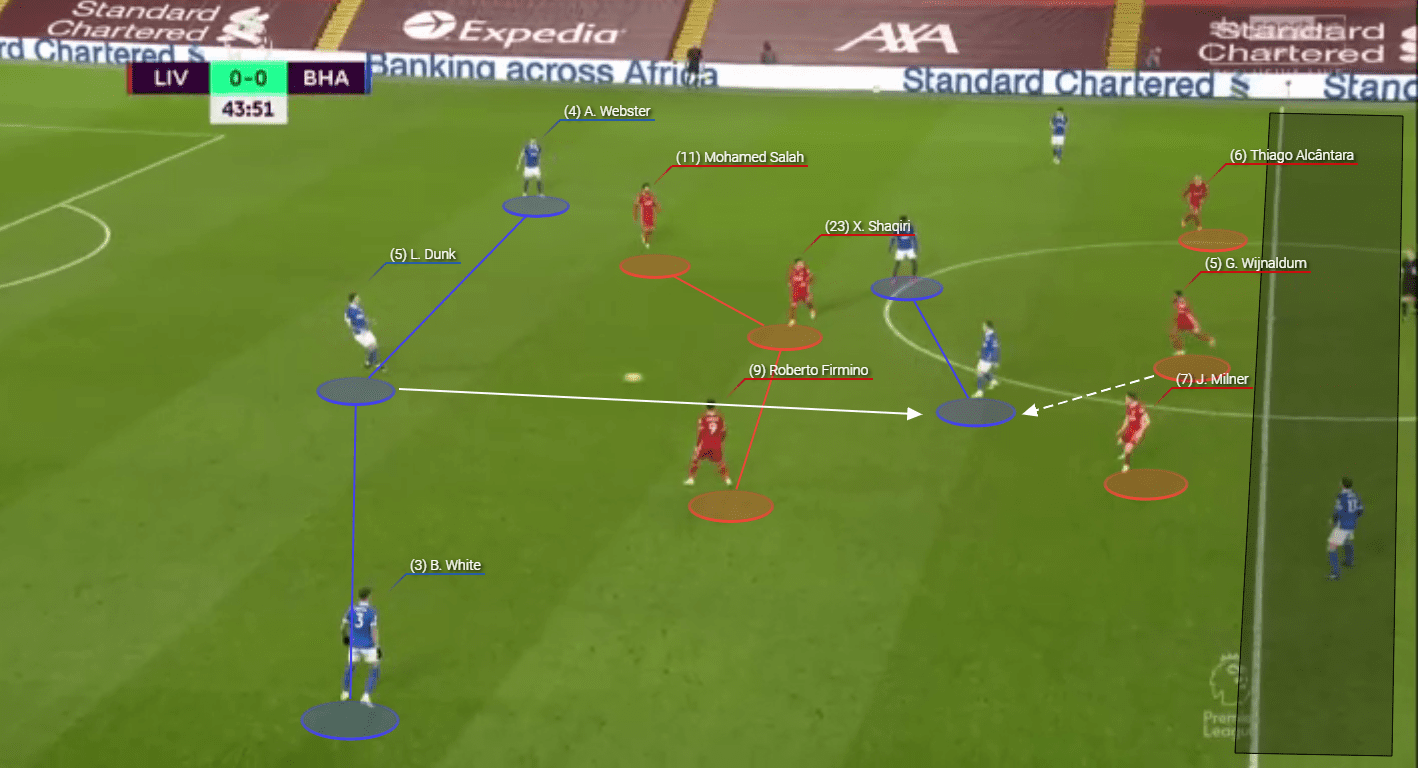
In the above image we see an example of this passive play from the match against Brighton. The opposition were allowed to move the ball across the first line, where they also had three players across the width of the pitch, comfortably with Liverpool not applying the pressure that we have come to expect from them. As with the examples of the City structure above we can see that Brighton were building-up with a 3-2 structure and as the ball moves centrally to the pivot it is Gini Wijnaldum, playing as the ‘6’ who moves to press and engage.
This press creates a flat midfield structure from Liverpool and we can see that this creates space behind that midfield.
This space is crucial as we know that City will look to access this area of the pitch to get their ‘8’s on the ball and then to move into the final third. Expect to see a lot of wall passes, passes forward and then back, into the double pivot from City as they look to pull Liverpool towards them before then accessing the space behind or around the midfield.
Liverpool are becoming passive in possession
If Pep Guardiola is a proponent of positional play in his game model Jurgen Klopp is perhaps more versatile in his approach. His arrival in England to take charge of Liverpool was met with the expectation that we would see a repitition of his game model from Borussia Dortmund that revolved around aggression, verticality and gegenpressing and indeed there were elements of this in his early Liverpool sides. Gradually, however, Klopp has adapted his approach to the Premier League with some elements and principles of positional play coming to the fore. This was especially true last season when Klopp begane to expect more control of matches from his side than we had seen previously.
There was still, however, one key principle that was non-negotiable and that was verticality in terms of passing and movement. Liverpool looked to progress quickly through the thirds in order to catch the opposition before they are set in a compact defensive block. In the match against Brighton that verticality in their passing was missing and a lot of the possession that Liverpool had throughout the match was relatively passive. Too often the ball was played backwards and then around to the other side when there were opportunities to find the vertical line breaking pass that were not taken.
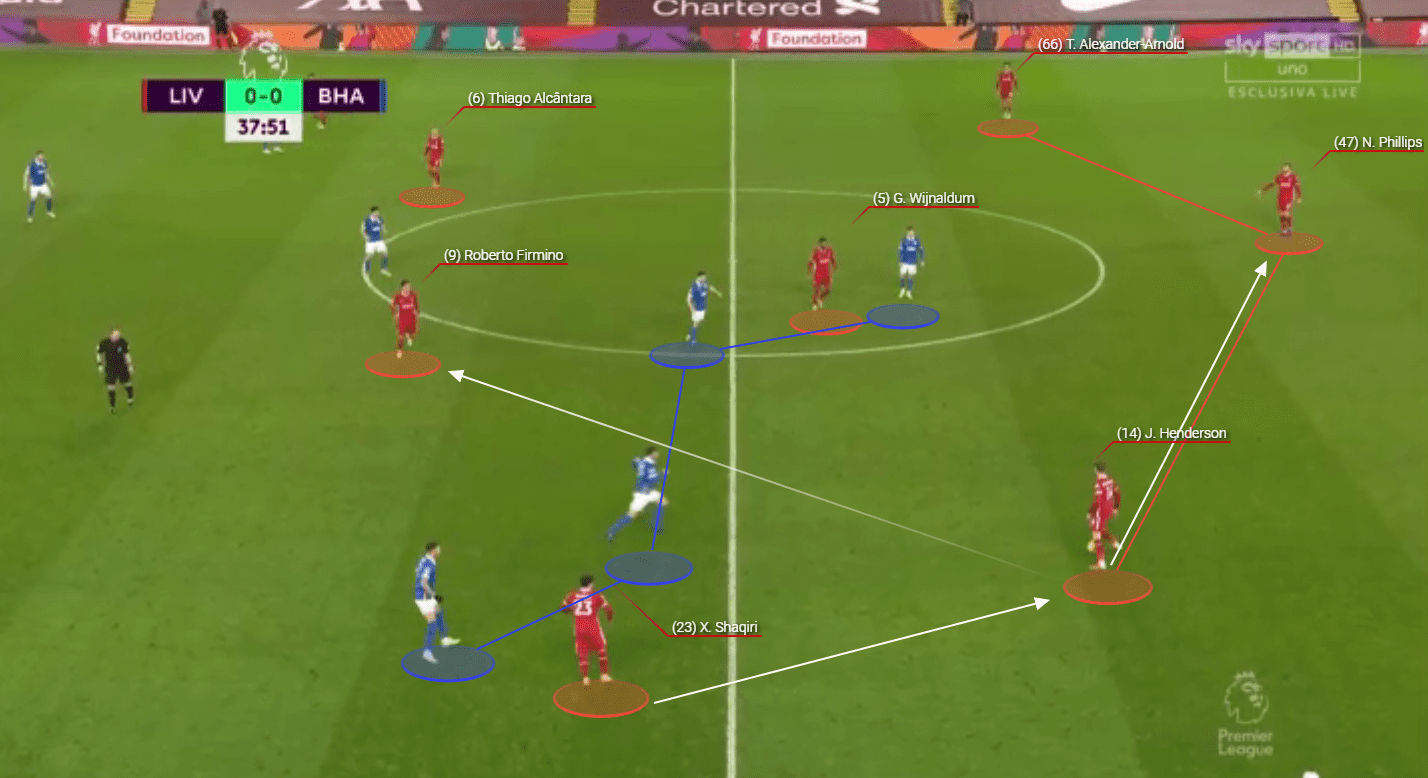
Take this example as a case in point. Liverpool had attempted to progress through the wide area and as Andy Robertson had moved high from the left-back slot we saw Xherdan Shaqiri drop back to receive the ball and then play back to Jordan Henderson as pressure was aplied. Now, it is at this moment that we are used to seeing Liverpool take the passing option that would break the line of the opposition defence and find Roberto Firmino in space behind the opposition midfield.
Instead. play was recycled back and across, passively.
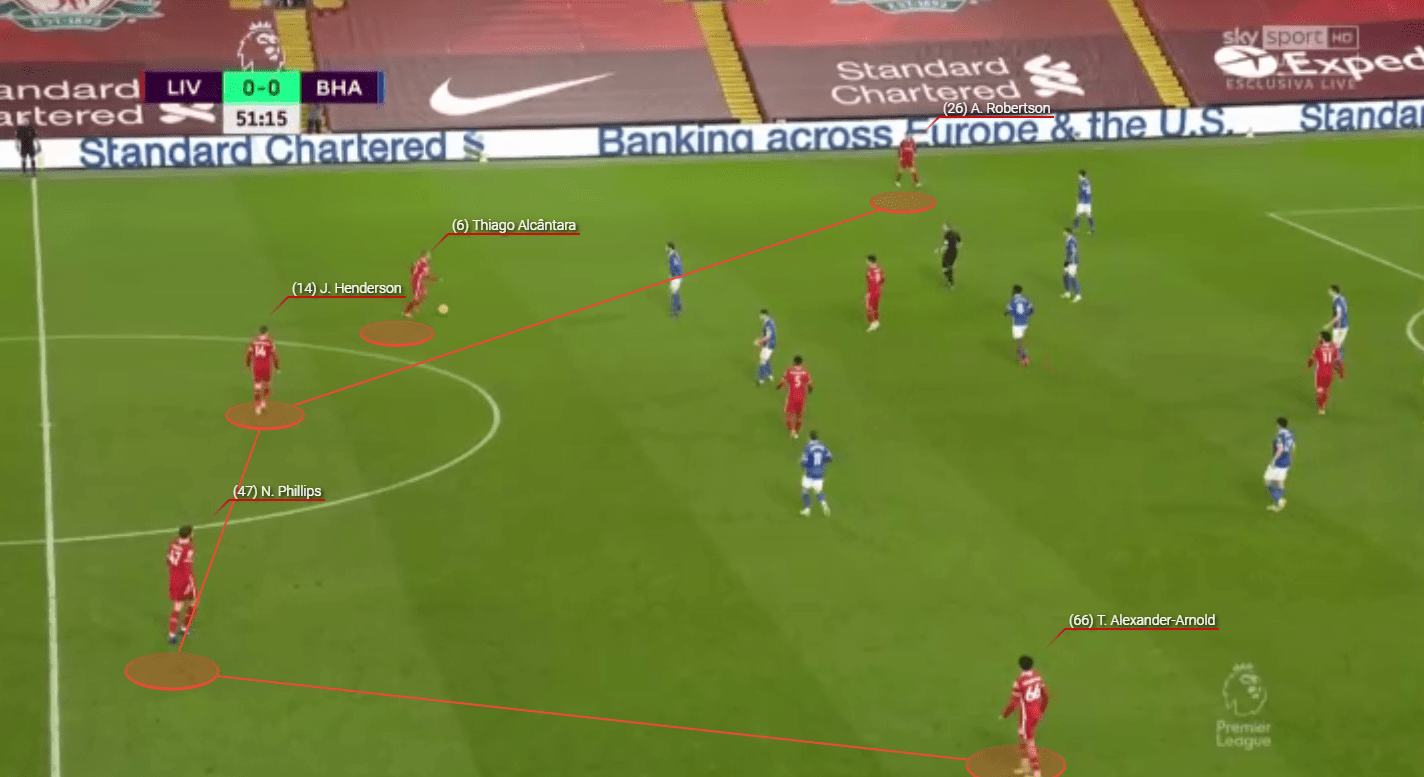
Throughout the match Liverpool looked to attack through the wide areas with the fullbacks as an attacking outlet. We continually saw Thiago dropping back towards the first-line to receive possession and then move Liverpool forward although again this was in the main down the wide areas.
With little intent to play centrally in order to balance their approach in possession we saw Brighton allow these passes into the wide areas before closing pressing traps or defending the attempt to access the area from these positions with relative ease.
City will no doubt welcome a similar attacking approach from Liverpool, especially if this is combined with passive possession from the first line.
Conclusion
Going into this match City feel like deserved favourites. They are controlling games with an ease that brings to mind their dominant seasons when they comfortably won the title. The tactical evolution of Joao Cancelo has created an option that Guardiola is able to use on either the left or the right hand side. This alone gives him flexibility in his approach.
While City are confident Liverpool look like a team that is lacking urgency. We should, however, again point out that this is largely down to the injury crisis that has so firmly enveloped the club. They signed two new central defenders in January with Ozan Kabak and Ben Davies joining. It remains to be seen, however, whether a match against this resurgent City side is the best place to give those players their first start at the club.






Comments